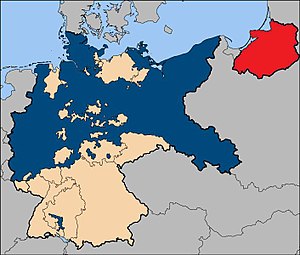
Back إخلاء شرق بروسيا Arabic Эвакуацыя Усходняй Прусіі Byelorussian Evacuación de Prusia Oriental Spanish Évacuation de la Prusse-Orientale French Evakuasi Prusia Timur ID مشرقی پروشیا دا انخلاء PNB Evacuação da Prússia Oriental Portuguese Evacuarea Prusiei Răsăritene Romanian Эвакуация Восточной Пруссии (1945) Russian مشرقی پروشیا کا انخلاء Urdu
| Evacuation of East Prussia | |||||||
|---|---|---|---|---|---|---|---|
| Part of German evacuation from Central and Eastern Europe during World War II | |||||||
 East Prussia (red) was separated from Germany and Prussia proper (blue) by the Polish corridor in the inter-war era. The area, divided between the Soviet Union and Poland in 1945, is 340 km east of the present-day Polish–German border. | |||||||
| |||||||
| Belligerents | |||||||
|
|
| ||||||
| Commanders and leaders | |||||||
| Gauleiter Erich Koch |
Ivan Chernyakhovsky Aleksandr Vasilevsky | ||||||
| Casualties and losses | |||||||
| 75,000–100,000 civilians[3][1][4] | |||||||
 |
| Flight and expulsion of Germans during and after World War II |
|---|
| (demographic estimates) |
| Background |
| Wartime flight and evacuation |
| Post-war flight and expulsion |
| Later emigration |
| Other themes |
The evacuation of East Prussia was the movement of German civilian population and military personnel from East Prussia between 20 January and March 1945, that was initially organized and carried out by state authorities but quickly turned into a chaotic flight from the Red Army.[5][6]
A part of the evacuation of German civilians towards the end of World War II, these events are not to be confused with the expulsion from East Prussia that followed after the war had ended. The area that was evacuated was not the Gau East Prussia, but the inter-war East Prussia where most people already held German citizenship. German citizens in Memel and other regions with proximity to East Prussia also took part in the evacuation, wishing to escape by sea, even though in their regions there was no official evacuation announced.
The evacuation, which had been delayed for months, was initiated due to fear of the Red Army advances during the East Prussian Offensive. Some parts of the evacuation were planned as a military necessity, Operation Hannibal being the most important military operation involved in the evacuation. However, many refugees took to the roads on their own initiative because of reported Soviet atrocities against Germans in the areas under Soviet control. Both spurious and factual accounts of Soviet atrocities were disseminated through the official news and propaganda outlets of Nazi Germany and by rumors that swept through the military and civilian populations.
Despite having detailed evacuation plans for some areas, the German authorities, including the Gauleiter of East Prussia, Erich Koch, delayed action until 20 January, when it was too late for an orderly evacuation, and the civil services and Nazi Party were eventually overwhelmed by the numbers of those wishing to evacuate. Coupled with the panic caused by the speed of the Soviet advance, civilians caught in the middle of combat, and the bitter winter weather, many thousands of refugees died during the evacuation period. The Soviet forces took control of East Prussia only in May 1945.[citation needed] According to the West German Schieder commission, the civilian population of East Prussia at the beginning of 1944 was 2,653,000[2] people. This accounting, which was based on ration cards, included air raid evacuees from western Germany and foreign workers. Before the end of the war an estimated 2 million people[1] were evacuated, including 500,000[7] in the autumn of 1944 and 1,500,000[1] after January 1945. An estimated 600,000[1] remained behind in Soviet-controlled East Prussia in April–May 1945.[8]
According to a 1974 West German government study, an estimated 1% of the civilian population was killed during the Soviet offensive.[3] The West German search service reported that 31,940 civilians from East Prussia, which also included Memel, were confirmed as killed during the evacuation.[9]
- ^ a b c d e f Schieder commission 1954, p. 78.
- ^ a b Schieder commission 1954, p. 78 Schieder included for East Prussia the pre-war population of 134,000 in Memel but excluded 310,000 from the regions of pre-war East Prussia that were administered as part of Reichsgau Danzig-West Prussia
- ^ a b German Federal Archive Spieler, Silke. ed. Vertreibung und Vertreibungsverbrechen 1945–1948. Bericht des Bundesarchivs vom 28. Mai 1974. Archivalien und ausgewählte Erlebnisberichte.. Bonn: Kulturstiftung der deutschen Vertriebenen. (1989). ISBN 3-88557-067-X. pp. 38–41
- ^ Schieder commission 1954, p. 65 Schieder estimated the loss of 75,000–100,000 German civilians in the territory of "Ostdeuschland" eastern Germany due to "Gewaltmassenahmen" violent acts. The total base population of the Schieder study was 11,924,000 persons
- ^ Eberhardt, Piotr (2006). Political Migrations in Poland 1939–1948. 8. Evacuation and flight of the German population to the Potsdam Germany (PDF). Warsaw: Didactica. ISBN 9781536110357. Archived from the original (PDF) on 26 June 2015.
- ^ Eberhardt, Piotr (2011). Political Migrations On Polish Territories (1939–1950) (PDF). Warsaw: Polish Academy of Sciences. ISBN 978-83-61590-46-0.
- ^ Schieder commission 1954, p. 41.
- ^ Schieder commission 1954, p. 41 Schieder presented a different set of figures for the territory of East Prussia and Memel that excluded 310,000 persons in the western regions that were included with the population of the province Reichsgau Danzig-West Prussia. Total population beginning of 1944: 2,350,000. Evacuated-In the fall of 1944: 500,000; after January 1945: 1,350,000. The balance of 500,000 were captured by the Soviet forces.
- ^ Gesamterhebung zur Klärung des Schicksals der deutschen Bevölkerung in den Vertreibungsgebieten. München : Zentralstelle des Kirchl. Suchdienstes. See Separate table "Heimatortskartei für Ostpreussen"
© MMXXIII Rich X Search. We shall prevail. All rights reserved. Rich X Search